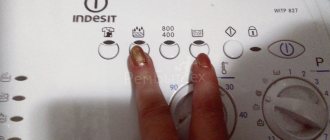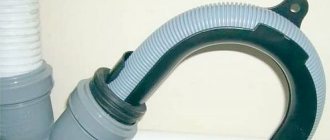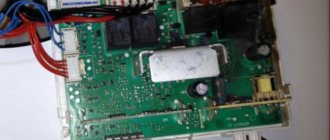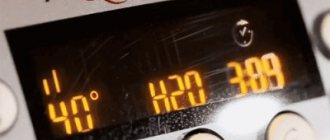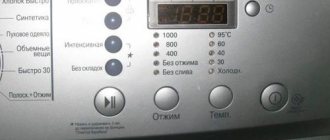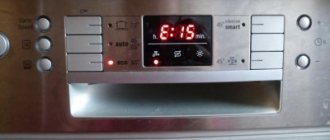The smooth operation of a washing machine greatly simplifies the life of a modern person. But suddenly reliable technology stops working.
When starting the program, the spiral machine does not turn on, indicating a problem with a flashing “lock” indicator.
There are several reasons why this situation can occur: from a trivially unclosed hatch door to serious damage to the control module.
Detailed information about why the “lock” indicator is on and the Indesit washing machine does not turn on will help you decide to repair the equipment yourself or use the services of a service center technician.
What to do first?
Before making final conclusions regarding the reasons for the Indesit washing machine not starting, it is necessary to carry out a number of manipulations to exclude serious damage and breakdowns.
What should be done:
Check that the loading hatch door is closed tightly.
The washing machine will never start the washing process if the door is not closed tightly (a kind of protection against leaks). The door is opened and closed again until the characteristic click of the hatch appears. If a click is not heard, you need to check the lock hole for foreign objects.- Check the water pressure in the tap. The thing is that with minimal pressure (or complete absence of water in the tap), the washing machine does not start. The control module receives a signal that the tank does not fill with water, to which the washing machine reacts by flashing the “lock” indicator and blocking the start of the selected washing program.
- Restart the washing machine. The slightest power surges in the network can cause a program failure. To reset the error and return the washing machine to work, you need to unplug the device, wait twenty minutes, and then restart the process by selecting the “drain and spin” mode.
Most often, after the manipulations have been carried out, the Indesit washing machine resumes normal operation. If it is not possible to achieve the desired result, then it is necessary to carry out more detailed diagnostics and repairs.
Repair Indesit Iwsc 5085
This model has a rather narrow drain hose. If the Indesit Iwsc 5085 washing machine does not turn on and water does not fill into the tank, it is recommended to check the pipe. To do this, the model needs to be turned with its back.
In this case, it is important to immediately disconnect the device from the network and water supply system. To turn off the water, you need to use a wrench
Next you will have to clean the pipe. You can use a regular rag for this.
If the integrity of the tube is damaged, it will have to be replaced. It's also worth noting that the problem can often be with the filter. The specified part is located at the bottom of this model. You can use a small stick to clean the filter. You will also need a little cotton wool.
What breakdowns can occur and how to fix them?
In most cases, you can fix the problem of a flashing “lock” and the washing machine not starting with your own hands. To do this, armed with the simplest tools (screwdriver, pliers), they carry out a series of simple repair work .
Replacing hinges
During operation of the washing machine, under the weight of hanging wet clothes, the hinges on the hatch door begin to sag and bend. The control module receives a signal that the door is not tightly closed, and as a result, the machine blocks the washing process.
The situation can be corrected by replacing loose hinges:
the washing machine is disconnected from the network;- open the hatch door, use pliers to loosen the clamp, push the rubber cuff inside the drum;
- carefully disconnect the wiring from the hatch lock;
- Unscrew the fixing bolts, remove the front panel and top cover of the washing machine;
- open the plastic casing hiding the door hinges;
- remove the hatch door hinges and install new elements in their place;
- Reassemble the washing machine in reverse order.
After replacing the loops, you need to turn on the machine and start the washing process. If the lock light continues to blink, you should pay attention to the hatch locking device.
Replace UBL (hatch blocking device)
Replacing the UBL yourself is not difficult. The main thing is to choose the right new element (the reference point is the serial number of the washing machine) and strictly adhere to a certain sequence of actions:
- Open the hatch.
- Bend the seal, open access to the clamp, and tuck the rubber cuff inside the washer.
- Remove the mounting screws.
- Remove the lock and disconnect it from the wiring.
- Install a new element in place of the dismantled lock.
- Connect the UBL to the wiring and assemble the machine in the reverse order.
Work is carried out only in a washing machine that is de-energized.
Pressostat
The sensor responsible for the required water level during the washing process is a pressure switch. If this element fails, a corresponding signal is sent to the control module of the washing machine, blocking the washing process.
Replacing the pressure switch will help fix the problem:
- the washing machine is unplugged and moved slightly away from the wall;
- unscrew the fixing elements, remove the top panel;
- inspect the pressure switch (located on the right side of the washing machine body) for blockages and integrity of the contacts.
The pressure switch is an element that cannot be repaired. At the slightest sign of malfunction, it is simply replaced. Read about how to do this here.
Pressure switch or heater
A lit lock indicator often indicates interruptions in the operation of the pressure switch. If the water level sensor does not signal that the tank is full, the self-diagnosis system detects the breakdown, stops the intake and reports the error with the appropriate indication. Finding the water meter is not difficult: it is located on the right side of the washer under the top cover. Diagnostics is carried out as follows: first, the device is inspected for the integrity of the body and tube, then the presence of blockages, the quality of adjustment and the reliability of contacts are checked. If any malfunctions are noticed, the device is replaced with a new one.
The “Key” light also comes on when the heater is broken. Here the situation is more complicated, because the machine will wash in cold water if the heating element is not working, but there is a high risk of fire and current leakage to the body. For the sake of your own safety and the safety of your property, it is worth assessing the performance of the heating element: remove the back panel, inspect the wiring and measure the resistance readings with a multimeter. If the values deviate from the norm, we purchase a new device and install it instead of the old one.
Call the master
In cases where you lack the skills to repair washing machines or the actions taken did not lead to the desired result, you cannot do without the help of a specialist .
To call a specialist to your home, you can use the services of service centers (contacts are not difficult to find on the Internet). The main thing before filling out the application is to indicate as accurately as possible the type of breakdown, the model and brand of the washing machine, and the year of manufacture of the household appliance.
Depending on the cause of the washer malfunction, the average cost of a technician’s services will be:
- Replacing a hatch locking device on average costs RUB 4,500.
- Replacement of hinges - 2000 rubles.
- Diagnostics and repair of the control module - 4,500 rubles. (replacement starts from RUB 5,500).
The cost of the work will be announced by the technician after inspection and detailed diagnostics of the washing machine. If a specialist asked for a certain amount of money even before the repair began, it’s worth thinking about whether this person is really a master and not a fraudster?
A lot of important and useful information about repairing Indesit washing machines is presented in this section.
Why doesn't the washing machine motor work?
The operation of the motor ensures normal rotation of the tank and drum through the drive belt. To understand the reasons for the breakdown, find out what type of motor is in your washing machine. This information is indicated in the technical documentation.
Types of motors:
- Collector. These days they are the most common. The composition includes a stator and a rotor, a tachometer, and two brushes. Main advantages: stable operation from alternating and direct current. Disadvantages: Requires regular replacement of brushes.
- Asynchronous. You won’t find this type of motor in modern models. But if your washing machine (WM) was manufactured before 2000, it may have an asynchronous machine installed. The two-phase unit consists of a stationary stator and rotor. The advantages of the design are simple maintenance and quiet operation. The disadvantages are large dimensions and low efficiency.
- Inverter with direct drive. It is also based on a rotor, stator, and tachometer. But the operating principle is different. The inverter is directly attached to the tank and does not require a belt. This approach avoids many operational problems.
Once you determine the type of motor, start looking for the reason why it does not start.
Brush wear. A similar malfunction is typical for commutator motors. The design has two brushes that transmit current from the external circuit to the rotor, causing it to rotate. Their graphite rods are constantly in contact with the rotor surface, causing them to wear out. You may smell a burning smell or notice sparking.
The problem is in the windings. If the engine does not turn on or runs at low power, with hesitations, inspect the windings. The reason may be a short circuit or break. If a break occurs, the unit overheats, causing protective thermal sensors to shut down its operation.
Peeling of lamellas. Problems with the slats indicate improper operation of the equipment. The reason may be a break in the cord with the rotor winding. It's worse if the coating peels off due to heat. This happens when there is a short circuit (short circuit) or blocking of the bearings.
Other reasons for program crashes and blinking indicators
The LEDs on the control panel may blink not only due to a breakdown, but also due to incorrectly set parameters. There are a number of washing modes that provide the ability to connect additional functions:
- additional rinse
- higher degree of water heating,
- ironing
Instead of turning on, the indicator may flash if the selected program cycle does not provide a particular function.
The machine can generate a service error both at the initial stage of washing and during it. In cases where the weight of the load of laundry is not comparable to the number of revolutions or the maximum allowable volume of laundry provided for by the technical specifications, the spin process may not start. In this case, the buttons indicating a failure in the “Rinse” and “Spin” modes and the door lock indicator will start flashing. At this moment, it is necessary to restart the machine a second time, reducing the number of things.
After this, the execution of the specified program will stop. After a few seconds, the door will unlock, allowing you to make adjustments and start washing.



